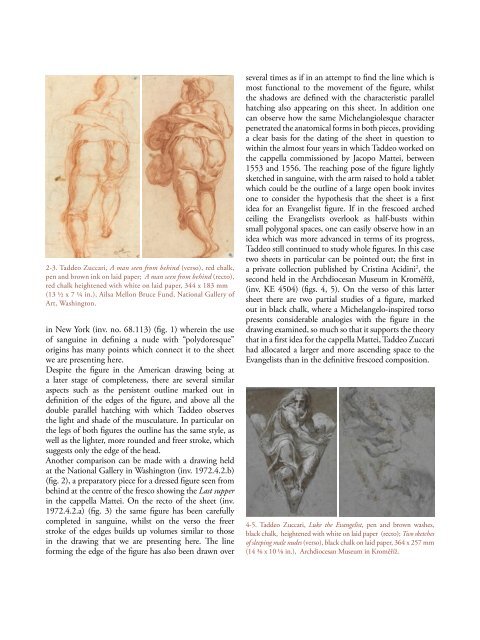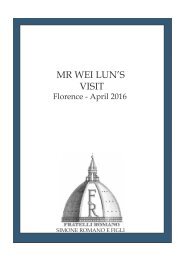A selection of master drawings 2016
- No tags were found...
You also want an ePaper? Increase the reach of your titles
YUMPU automatically turns print PDFs into web optimized ePapers that Google loves.
2-3. Taddeo Zuccari, A man seen from behind (verso), red chalk,<br />
pen and brown ink on laid paper; A man seen from behind (recto),<br />
red chalk heightened with white on laid paper, 344 x 183 mm<br />
(13 ½ x 7 ¼ in.), Ailsa Mellon Bruce Fund, National Gallery <strong>of</strong><br />
Art, Washington.<br />
in New York (inv. no. 68.113) (fig. 1) wherein the use<br />
<strong>of</strong> sanguine in defining a nude with “polydoresque”<br />
origins has many points which connect it to the sheet<br />
we are presenting here.<br />
Despite the figure in the American drawing being at<br />
a later stage <strong>of</strong> completeness, there are several similar<br />
aspects such as the persistent outline marked out in<br />
definition <strong>of</strong> the edges <strong>of</strong> the figure, and above all the<br />
double parallel hatching with which Taddeo observes<br />
the light and shade <strong>of</strong> the musculature. In particular on<br />
the legs <strong>of</strong> both figures the outline has the same style, as<br />
well as the lighter, more rounded and freer stroke, which<br />
suggests only the edge <strong>of</strong> the head.<br />
Another comparison can be made with a drawing held<br />
at the National Gallery in Washington (inv. 1972.4.2.b)<br />
(fig. 2), a preparatory piece for a dressed figure seen from<br />
behind at the centre <strong>of</strong> the fresco showing the Last supper<br />
in the cappella Mattei. On the recto <strong>of</strong> the sheet (inv.<br />
1972.4.2.a) (fig. 3) the same figure has been carefully<br />
completed in sanguine, whilst on the verso the freer<br />
stroke <strong>of</strong> the edges builds up volumes similar to those<br />
in the drawing that we are presenting here. The line<br />
forming the edge <strong>of</strong> the figure has also been drawn over<br />
several times as if in an attempt to find the line which is<br />
most functional to the movement <strong>of</strong> the figure, whilst<br />
the shadows are defined with the characteristic parallel<br />
hatching also appearing on this sheet. In addition one<br />
can observe how the same Michelangiolesque character<br />
penetrated the anatomical forms in both pieces, providing<br />
a clear basis for the dating <strong>of</strong> the sheet in question to<br />
within the almost four years in which Taddeo worked on<br />
the cappella commissioned by Jacopo Mattei, between<br />
1553 and 1556. The reaching pose <strong>of</strong> the figure lightly<br />
sketched in sanguine, with the arm raised to hold a tablet<br />
which could be the outline <strong>of</strong> a large open book invites<br />
one to consider the hypothesis that the sheet is a first<br />
idea for an Evangelist figure. If in the frescoed arched<br />
ceiling the Evangelists overlook as half-busts within<br />
small polygonal spaces, one can easily observe how in an<br />
idea which was more advanced in terms <strong>of</strong> its progress,<br />
Taddeo still continued to study whole figures. In this case<br />
two sheets in particular can be pointed out; the first in<br />
a private collection published by Cristina Acidini 2 , the<br />
second held in the Archdiocesan Museum in Kroměříž,<br />
(inv. KE 4504) (figs. 4, 5). On the verso <strong>of</strong> this latter<br />
sheet there are two partial studies <strong>of</strong> a figure, marked<br />
out in black chalk, where a Michelangelo-inspired torso<br />
presents considerable analogies with the figure in the<br />
drawing examined, so much so that it supports the theory<br />
that in a first idea for the cappella Mattei, Taddeo Zuccari<br />
had allocated a larger and more ascending space to the<br />
Evangelists than in the definitive frescoed composition.<br />
4-5. Taddeo Zuccari, Luke the Evangelist, pen and brown washes,<br />
black chalk, heightened with white on laid paper (recto); Two sketches<br />
<strong>of</strong> sleeping male nudes (verso), black chalk on laid paper, 364 x 257 mm<br />
(14 ⅜ x 10 ⅛ in.), Archdiocesan Museum in Kroměříž.





